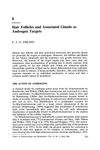TLDR Testosterone, DHT, and estradiol significantly affect hair cell growth.
The study investigated the effects of testosterone, dihydrotestosterone (DHT), and estradiol on the growth of human hair outer root sheath keratinocytes in vitro. The research aimed to understand how these hormones influenced hair growth at the cellular level. The findings suggested that these hormones played a significant role in regulating the growth of keratinocytes, which are crucial for hair development. The study provided insights into the hormonal regulation of hair growth, which could have implications for understanding conditions like androgenetic alopecia. However, the document did not specify the number of participants or detailed experimental results.
22 citations
,
July 1990 in “Acta Dermato Venereologica”  51 citations
,
January 1989 in “Journal of Investigative Dermatology”
51 citations
,
January 1989 in “Journal of Investigative Dermatology” Men with male-pattern baldness have more androgen receptors in their scalp's oil glands, which may contribute to hair loss.
25 citations
,
January 1988 in “Journal of Investigative Dermatology” 28 citations
,
November 1987 in “Journal of the American Academy of Dermatology” 135 citations
,
November 1987 in “Differentiation” 39 citations
,
July 1987 in “Journal of Investigative Dermatology”  53 citations
,
May 1986 in “Clinics in endocrinology and metabolism”
53 citations
,
May 1986 in “Clinics in endocrinology and metabolism” Androgens like testosterone affect hair growth and oil production differently across body parts and individuals.
 August 2014 in “Journal of clinical & experimental dermatology research”
August 2014 in “Journal of clinical & experimental dermatology research” Platelet-released growth factors can treat hair loss by activating hair follicle stem cells, blocking certain pathways, and controlling inflammation and fibrosis.
10 citations
,
October 2000 in “PubMed”  94 citations
,
February 1994 in “The journal of investigative dermatology/Journal of investigative dermatology”
94 citations
,
February 1994 in “The journal of investigative dermatology/Journal of investigative dermatology” EGF makes hair follicles grow longer but stops hair production.
59 citations
,
August 1981 in “PubMed” The study described trichilemmal keratinization as a distinct type of keratinization in the hair follicle, characterized by the conversion of the outer root sheath's stratified epithelium into anuclear keratin without a keratohyalin layer. This process was observed in the anagen phase below the sebaceous duct opening and in the catagen phase within the trichilemmal sac. The research, using electron microscopy on dog hairs, revealed complex infoldings of cells and unique ladder-like membrane coating granules in anagen, which were acid phosphatase-positive and potentially involved in the disintegration of the inner root sheath.



